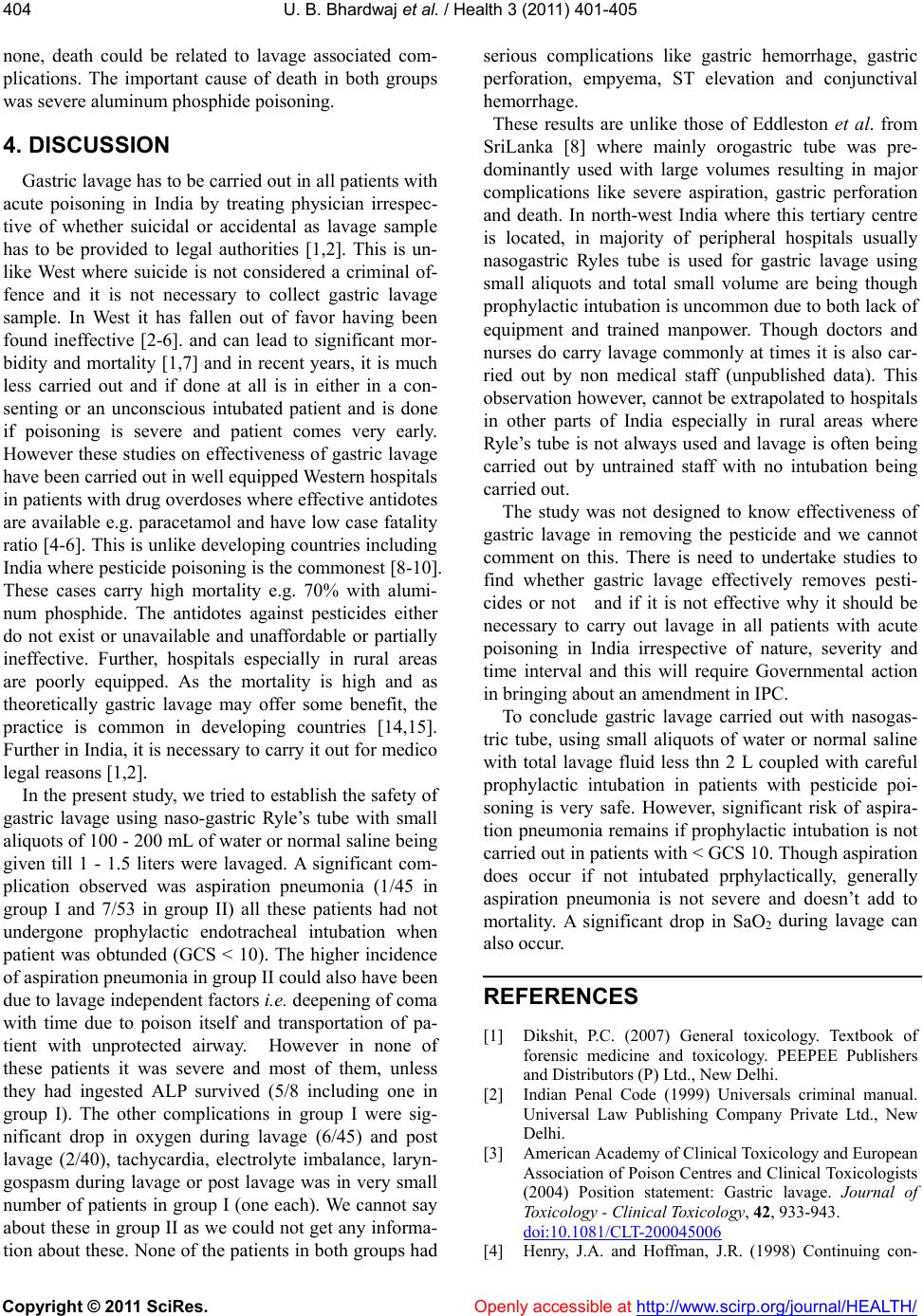
U. B. Bhardwaj et al. / Health 3 (2011) 401-405
Copyright © 2011 SciRes. Openly accessible at http://www.scirp.org/journal/HEALTH/
404
none, death could be related to lavage associated com-
plications. The important cause of death in both groups
was severe aluminum phosphide poisoning.
4. DISCUSSION
Gastric lavage has to be carried out in all patients with
acute poisoning in India by treating physician irrespec-
tive of whether suicidal or accidental as lavage sample
has to be provided to legal authorities [1,2]. This is un-
like West where suicide is not considered a criminal of-
fence and it is not necessary to collect gastric lavage
sample. In West it has fallen out of favor having been
found ineffective [2-6]. and can lead to significant mor-
bidity and mortality [1,7] and in recent years, it is much
less carried out and if done at all is in either in a con-
senting or an unconscious intubated patient and is done
if poisoning is severe and patient comes very early.
However these studies on effectiveness of gastric lavage
have been carried out in well eq u ipped Western ho sp itals
in patients with drug overdoses wh ere effective antidotes
are available e.g. paracetamol and have low case fatality
ratio [4-6]. This is un like developing countries including
India where pesticide poisoning is the commonest [8-10].
These cases carry high mortality e.g. 70% with alumi-
num phosphide. The antidotes against pesticides either
do not exist or unavailable and unaffordable or partially
ineffective. Further, hospitals especially in rural areas
are poorly equipped. As the mortality is high and as
theoretically gastric lavage may offer some benefit, the
practice is common in developing countries [14,15].
Further in India, it is necessary to carry it out for medico
legal reasons [1,2].
In the present study, we tried to establish the safety of
gastric lavage using naso-gastric Ryle’s tube with small
aliquots of 100 - 200 mL of water or normal saline being
given till 1 - 1.5 liters were lavaged. A significant com-
plication observed was aspiration pneumonia (1/45 in
group I and 7/53 in group II) all these patients had not
undergone prophylactic endotracheal intubation when
patient was obtunded (GCS < 10). The higher incidence
of aspiration pneumonia in group II could also have been
due to lavage independent factors i.e. deep enin g of co ma
with time due to poison itself and transportation of pa-
tient with unprotected airway. However in none of
these patients it was severe and most of them, unless
they had ingested ALP survived (5/8 including one in
group I). The other complications in group I were sig-
nificant drop in oxygen during lavage (6/45) and post
lavage (2/40), tachycardia, electrolyte imbalance, laryn-
gospasm during lavage or post lavage was in very small
number of patients in group I (one each). We cannot say
about these in group II as we could not get any informa-
tion about these. None of the patients in both groups had
serious complications like gastric hemorrhage, gastric
perforation, empyema, ST elevation and conjunctival
hemorrhage.
These results are unlike those of Eddleston et al. from
SriLanka [8] where mainly orogastric tube was pre-
dominantly used with large volumes resulting in major
complications like severe aspiration, gastric perforation
and death. In north-west India where this tertiary centre
is located, in majority of peripheral hospitals usually
nasogastric Ryles tube is used for gastric lavage using
small aliquots and total small volume are being though
prophylactic intubation is uncommon due to both lack of
equipment and trained manpower. Though doctors and
nurses do carry lavage commonly at times it is also car-
ried out by non medical staff (unpublished data). This
observation however, cannot be extrapolated to hospitals
in other parts of India especially in rural areas where
Ryle’s tube is not always used and lavage is often being
carried out by untrained staff with no intubation being
carried out.
The study was not designed to know effectiveness of
gastric lavage in removing the pesticide and we cannot
comment on this. There is need to undertake studies to
find whether gastric lavage effectively removes pesti-
cides or not and if it is not effective why it should be
necessary to carry out lavage in all patients with acute
poisoning in India irrespective of nature, severity and
time interval and this will require Governmental action
in bringing about an amendment in IPC.
To conclude gastric lavage carried out with nasogas-
tric tube, using small aliquots of water or normal saline
with total lavage fluid less thn 2 L coupled with careful
prophylactic intubation in patients with pesticide poi-
soning is very safe. However, significant risk of aspira-
tion pneumonia remains if prophylactic intubation is not
carried out in patients with < GCS 10. Though aspiration
does occur if not intubated prphylactically, generally
aspiration pneumonia is not severe and doesn’t add to
mortality. A significant drop in SaO2 during lavage can
also occur.
REFERENCES
[1] Dikshit, P.C. (2007) General toxicology. Textbook of
forensic medicine and toxicology. PEEPEE Publishers
and Distributors (P) Ltd., New Delhi.
[2] Indian Penal Code (1999) Universals criminal manual.
Universal Law Publishing Company Private Ltd., New
Delhi.
[3] American Academy of Clinical Toxicology and European
Association of Poison Centres and Clinical Toxicologists
(2004) Position statement: Gastric lavage. Journal of
Toxicology - Clinical Toxicology, 42, 933-943.
doi:10.1081/CLT-200045006
[4] Henry, J.A. and Hoffman, J.R. (1998) Continuing con-